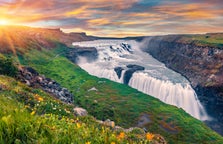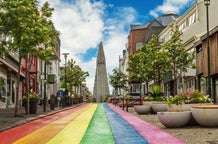
Top 11 Waterfalls in Iceland to See in Winter

- 11 Amazing Waterfalls to See in Iceland During Winter
- 11. Selfoss Waterfall
- 10. Kermoafoss Waterfall
- 9. Svartifoss Waterfall
- 8. Bruarfoss Waterfall
- 7. Seljalandsfoss Waterfall
- 6. Oxararfoss Waterfall
- 5. Aldeyjarfoss Waterfall
- 4. Kirkjufellsfoss Waterfall
- 3. Skogafoss Waterfall
- 2. Godafoss Waterfall
- 1. Gullfoss Waterfall
- The Top 5 Waterfalls in Iceland Under the Northern Lights
- 5. Oxararfoss Waterfall
- 4. Skogafoss Waterfall
- 3. Kirkjufellsfoss Waterfall
- 2. Gullfoss Waterfall
- 1. Godafoss Waterfall
Explore the amazing frozen waterfalls you can see in Iceland during the winter. Find out where they are, how to get there, and all the fascinating stories behind these beautiful waterfalls.
When visiting Iceland during the winter, there is no shortage of things to do and places to explore while traveling around the country. You can explore the insides of glaciers on adventurous ice cave tours, zoom across the white fluffy snow on thrilling snowmobile tours, or go hunting for those elusive lights in the sky, the aurora borealis.
With lower temperatures and shorter days during the winter, some might think visiting waterfalls is something you can only do during the summer. Not only is that not true, but seeing Iceland's waterfalls in their winter coat, bursting with white snow, glittering mist, and hanging icicles, is a unique experience different from seeing the same waterfalls during the summer.
Additionally, fewer people brave the cold during the winter, meaning it is much less crowded when visiting these waterfalls during the off-season, giving you a more up-close personal experience of these natural wonders. To top it all off, you might even see these waterfalls underneath the northern lights!

If you're interested in seeing these waterfalls in person, look at our wide selection of waterfall tours or rent a car on Iceland's most affordable car rental marketplace and drive there yourself.
11 Amazing Waterfalls to See in Iceland During Winter
These eleven waterfalls are our favorites to go visit during the Icelandic winter. Of course, it's always hard to evaluate the beauty of natural wonders and compare them against each other, but we've done our best to choose our absolute favorites, which we recommend visitors to go see. Just make sure to wake up early before embarking on your waterfall journey, as it gets dark early during the Icelandic winters, and it would be a shame to reach your destination when it's shrouded in darkness!
11. Selfoss Waterfall
 We start the countdown with this beauty, located in North Iceland, about 100 miles (160 kilometers) from the town of Akureyri.
We start the countdown with this beauty, located in North Iceland, about 100 miles (160 kilometers) from the town of Akureyri.
The most notable characteristic of Selfoss waterfall is that its much broader than tall. The height only reaches about 36 feet (11 meters) at its highest while it's 330 feet (100 meters) wide. Therefore, visitors must turn their heads (or be far away) to see the entire waterfall!
Selfoss waterfall is one of the stops on the popular Diamond Circle route, along with natural wonders such as Lake Myvatn and Dettifoss waterfall. You can reach it on this 9-Hour Diamond Circle Tour from Akureyri with an expert guide.
You might be thinking, how can a breathtaking waterfall like this not be higher on the list? The reason is that it's not easily accessible for solo travelers during the winter. It's far away from the nearest town and requires a bit of hiking to get there, preferably on crampons! Be mindful that the cliffs from across the waterfall can get very slippery during the winter.
Therefore, we advise any adventurous travelers that want to see this waterfall during winter to be extra careful, dress warm and stay a safe distance from the edge of the cliffs. Also, make sure not to confuse this waterfall with Selfoss, a town of the same name in South Iceland, when putting it in your navigation system!
10. Kermoafoss Waterfall
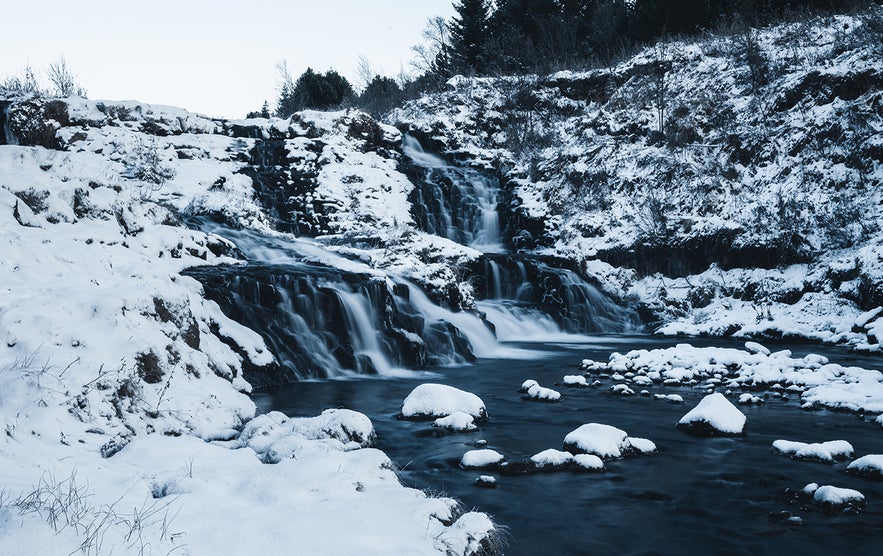 Sometimes, you don't need to go very far to see a beautiful waterfall in Iceland in all its winter glory! That is certainly the case with Kermoafoss Waterfall, which is only a short distance from Reykjavik's city center.
Sometimes, you don't need to go very far to see a beautiful waterfall in Iceland in all its winter glory! That is certainly the case with Kermoafoss Waterfall, which is only a short distance from Reykjavik's city center.
Kermoafoss waterfall is located in Ellidarardalur valley, a small public park in Reykjavik centered around the Ellidara river, which runs through parts of the city.
The park also has beautiful pine trees, walking paths through lava fields, and benches to rest on and take in the environment. You can even spot rabbits hopping around if you're lucky!
If you're staying in Reykjavik, you can easily get to the park where this frozen waterfall is located by using the Reykjavik city bus system or with a 15-20 minute drive from the downtown area, in case you have a rental car of your own.
9. Svartifoss Waterfall
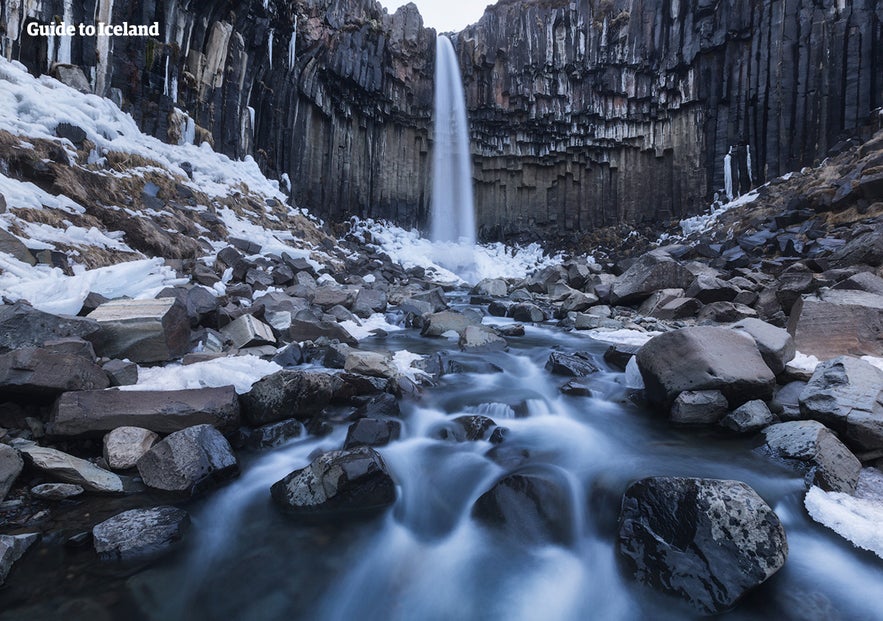 This striking waterfall is impressive at any time of year, but it gets even more dramatic during the winter. The flowing glacial water creates white snow and shiny icicles along the stark black hexagonal basalt columns, creating a piece of art in nature. It is from those dark columns Svartifoss waterfall gets its name, which translates to "Black Falls."
This striking waterfall is impressive at any time of year, but it gets even more dramatic during the winter. The flowing glacial water creates white snow and shiny icicles along the stark black hexagonal basalt columns, creating a piece of art in nature. It is from those dark columns Svartifoss waterfall gets its name, which translates to "Black Falls."
The waterfall is 65 feet (20 meters) tall, and the colder it gets, the larger the icicles on the cliff can become. Fortunately, there is a bridge across the river the waterfall flows into, which also serves as a viewing platform for this frozen waterfall. Therefore, visitors won't have to walk on the slippery rocks surrounding its flow.
Svartifoss is located within the Skaftafell Nature Reserve in Southeast Iceland, and the hike from the Skaftafell visitor center is about one mile (1.5 kilometers). When hiking toward the waterfall, you will pass three smaller waterfalls along the way, making the walk up the river's east bank more enjoyable and giving you plenty of photography opportunities!
8. Bruarfoss Waterfall
 Even during the summer, the Bruarfoss waterfall always looks wintery with its icy blue water and white rapids. Therefore, it seems even more striking when the cold season rolls around as the snow settles along its banks and the rocks become covered in sparkling ice.
Even during the summer, the Bruarfoss waterfall always looks wintery with its icy blue water and white rapids. Therefore, it seems even more striking when the cold season rolls around as the snow settles along its banks and the rocks become covered in sparkling ice.
The waterfall's shape is peculiar, as it's almost v-shaped and not particularly tall. Its unique azure-colored water makes Bruarfoss waterfall a stand-out and a popular destination among travelers in the Southwest of Iceland.
If you're interested in visiting this waterfall during the winter, be warned that it takes about a one-hour hike on a gravel path to reach it (and another hour to get back). But before reaching Bruarfoss, you will pass by two other beautiful falls along the way, Hlauptungufoss, and Midfoss, which share the same gorgeous blue water of the Bruara river.
7. Seljalandsfoss Waterfall
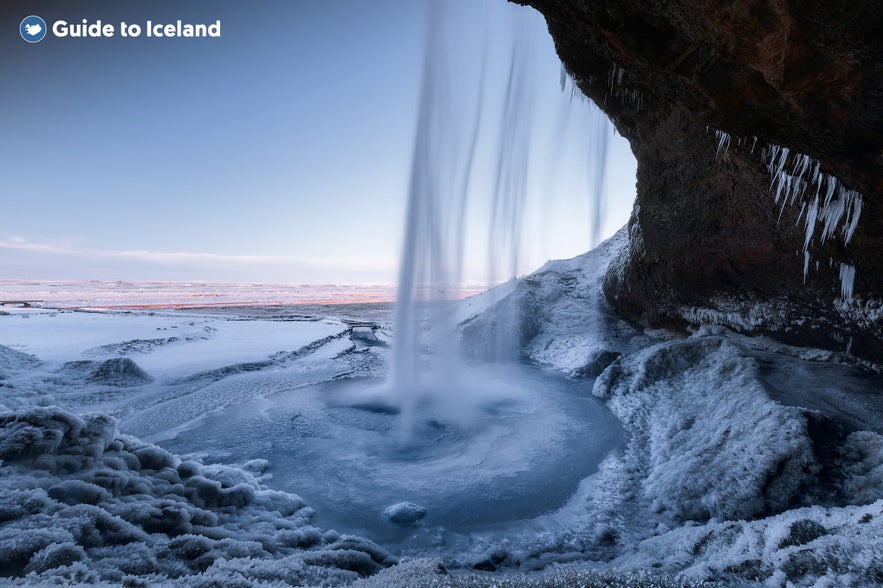 Being one of Iceland's most cherished waterfalls, Seljalandsfoss is definitely among our favorite waterfalls to see in the winter. It is pretty narrow and is 197 feet (60 meters) tall as it falls down dramatic cliffs, making it very picturesque no matter where you're standing. Just point a camera towards it and click the button randomly; it's guaranteed to be a great photo!
Being one of Iceland's most cherished waterfalls, Seljalandsfoss is definitely among our favorite waterfalls to see in the winter. It is pretty narrow and is 197 feet (60 meters) tall as it falls down dramatic cliffs, making it very picturesque no matter where you're standing. Just point a camera towards it and click the button randomly; it's guaranteed to be a great photo!
The unique feature of this waterfall is the trail circling the water flow, meaning you can walk behind the waterfall. However, the path gets so slippery during the winter that it's closed off for safety. That means the icicles along the cave can grow long, and the intricate crystal frostings on the rocks around the waterfall get to remain undisturbed while creating mesmerizing patterns.
Make sure to wear your raincoat (over your warm winter clothes!), and expect to get pretty wet if you want to see it up close. It also gets more slippery the closer you get, so wearing crampons on your hiking boots is also wise.
Seljalandsfoss waterfall is a popular stop in all of our South Coast tours in Iceland, making it easy to get to any time of year.
6. Oxararfoss Waterfall
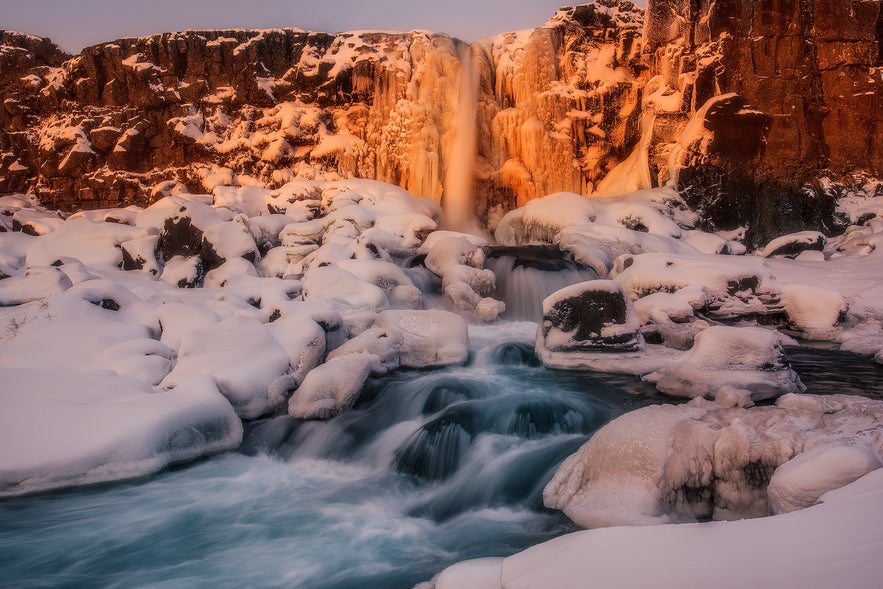 If you're looking to see a frozen waterfall in Iceland up close, Oxararfoss waterfall is probably your best bet. The waterfall is about 40 feet (12 meters) tall, and you can safely view it from a nearby path through the park. When it gets cold during the winter, this waterfall can become nearly frozen, with a barely visible flow of water hidden beneath the thick layers of ice.
If you're looking to see a frozen waterfall in Iceland up close, Oxararfoss waterfall is probably your best bet. The waterfall is about 40 feet (12 meters) tall, and you can safely view it from a nearby path through the park. When it gets cold during the winter, this waterfall can become nearly frozen, with a barely visible flow of water hidden beneath the thick layers of ice.
Oxararfoss is in the historic Thingvellir National Park, the founding site of Iceland's Althingi in the year 930, making it the oldest parliament in the world. It was also where Iceland's constitution was signed in 1944, making it doubly crucial in Iceland's history.
What makes this waterfall easily accessible is that it's part of the Golden Circle sightseeing route, which is very popular among travelers staying in Reykjavik. If you have a rental car, Thingvellir is about 30 miles (47 kilometers) from Reykjavik, making it about an hour-long drive under good conditions.
5. Aldeyjarfoss Waterfall
 When this waterfall is in its winter coat, it barely looks like it's from Earth! The half-frozen water flowing over glistening basalt columns into the icy blue pond surrounded by white snow makes the scene look like a fantastical winter wonderland!
When this waterfall is in its winter coat, it barely looks like it's from Earth! The half-frozen water flowing over glistening basalt columns into the icy blue pond surrounded by white snow makes the scene look like a fantastical winter wonderland!
Basalt columns, such as the ones surrounding this waterfall, get formed when lava cools rapidly following a volcanic eruption. When the weather is cold, they freeze while keeping their hexagonal shape. This gives this waterfall its unique look in the winter, nearly making it look like a sculpture.
Aldeyjarfoss waterfall is located in the northern Highlands of Iceland, making it tricky to get to, but worth it for those brave enough to make the trek. You can drive close to the waterfall on Iceland's infamous F-roads during the summer. But during the winter, all F-roads get closed off.

Therefore, to get there, you will need to drive on Route 842 towards the waterfall and park your car at the parking lot where the F road starts. The route is a gravel road and could be very snowy, so you must rent a 4x4 vehicle to traverse it.
From there, you will need to hike for two miles (three kilometers) on a slippery path toward the waterfall. Wearing crampons for grip is very important, and be careful not to rush.
Once you're there and still feeling energetic, you could keep hiking south for another two miles (three kilometers) and reach another beautiful waterfall, Hrafnbjargafoss, which you can see in the opening paragraph of this article (it just missed the Top 11!)
4. Kirkjufellsfoss Waterfall
 Kirkjufellsfoss waterfall on the beautiful Snaefellsnes peninsula is petite but packs a punch with its incredible surroundings. It's in front of the iconic Mount Kirkjufell, which the waterfall is named after. The mountain offers a dramatic backdrop for this waterfall that tends to freeze over during the height of winter. Therefore, it is nearly impossible to take a bad picture of it!
Kirkjufellsfoss waterfall on the beautiful Snaefellsnes peninsula is petite but packs a punch with its incredible surroundings. It's in front of the iconic Mount Kirkjufell, which the waterfall is named after. The mountain offers a dramatic backdrop for this waterfall that tends to freeze over during the height of winter. Therefore, it is nearly impossible to take a bad picture of it!
Another thing that makes this a perfect waterfall to see during the winter is that there is no hiking required to see it up close. The waterfall is just outside of the town of Grundarfjordur, with the main road leading right up to it.
 The distance between Reykjavik and Kirkjufellsfoss waterfall is about 110 miles (180 kilometers), so it's not too far for a day trip. The peninsula the waterfall is located on is worth a visit. Aside from other beautiful waterfalls and dramatic mountains, it also has charming villages, mysterious caves, deep ravines, hot springs, and the famous Snaefellsjokull glacier.
The distance between Reykjavik and Kirkjufellsfoss waterfall is about 110 miles (180 kilometers), so it's not too far for a day trip. The peninsula the waterfall is located on is worth a visit. Aside from other beautiful waterfalls and dramatic mountains, it also has charming villages, mysterious caves, deep ravines, hot springs, and the famous Snaefellsjokull glacier.
You can choose from a wide selection of Snaefellsnes tours and explore this fantastic region. It's sometimes called 'Iceland in miniature' as it contains many characteristics of Icelandic nature, all within a short distance.
3. Skogafoss Waterfall

Photo by Anuraag Rajasekhar
As we get near the top of the list, all these waterfalls are amazing to see during winter, including our third entry, Skogafoss waterfall. With an impressive height of 197 feet (60 meters) and a width of 82 feet (25 meters), the water seems to fall in slow motion as it turns into snow and ice on the cliffs surrounding the waterfall.
On top of being one of Iceland's natural wonders, there are rumors that treasure can be found in the cave behind the waterfall. A sorcerer named Thrasi Thorlaksson was said to have buried his treasure chest there centuries ago. However, nothing has been found except the ring on the trunk itself, which you can see when you visit the Skogar museum nearby.
 Skogafoss waterfall is one of the most visited waterfalls in Iceland for good reasons. It is easily accessible from the Ring Road, meaning you don't need to hike or drive on gravel roads to reach it. During the summer, a walkway up the cliff is open for visitors to view the waterfall from above, but it is closed during winter as it gets frozen over.
Skogafoss waterfall is one of the most visited waterfalls in Iceland for good reasons. It is easily accessible from the Ring Road, meaning you don't need to hike or drive on gravel roads to reach it. During the summer, a walkway up the cliff is open for visitors to view the waterfall from above, but it is closed during winter as it gets frozen over.
Another reason why it's popular is that it's a classic stop on most of the South Coast tours in Iceland, along with our entry number seven, Seljalandsfoss waterfall. Therefore, you can see two of the most amazing frozen waterfalls in Iceland in one day!
2. Godafoss Waterfall

This historic waterfall can be found in northern Iceland, just about 21 miles (35 kilometers) from the town of Akureyri. Its unique half-circular shape makes the Godafoss waterfall stand out, as it's more than twice as wide as it is tall. It measures around 39 feet (12 meters) high and 98 feet (30 meters) wide.
Because of its immense width, there are many places along the waterfall's crest line where snow can build up, making the waterfall look frozen. Across from the waterfall is a viewing platform where you can view it safely from a short distance.
The platform is at a slightly higher elevation than the waterfall, and there are no obstructions, so it is also a great place to see the northern lights after dark. Make sure you dress appropriately in your best winter attire, as this site can get very cold.
 Not only is Godafoss waterfall breathtaking to see, but it also has a fascinating history. This is where Iceland's lawspeaker, Thorgeir Ljosvetningagodi, tossed his Norse idols when Iceland became Christianized in the year 1000.
Not only is Godafoss waterfall breathtaking to see, but it also has a fascinating history. This is where Iceland's lawspeaker, Thorgeir Ljosvetningagodi, tossed his Norse idols when Iceland became Christianized in the year 1000.
This was a landmark event in Icelandic history, as before that, most Icelanders worshipped the old Norse gods, such as Odin, Thor, and Freya. The waterfall takes its name from this historical event, translating to "Waterfall of the Gods."
You can easily reach the waterfall by driving from Akureyri on Route 1, and no hiking or driving on gravel roads is required. You can also book this guided 9-hour North Iceland tour from Akureyri, which includes a stop at Godafoss waterfall, the beautiful Lake Myvatn, and another famous waterfall, Dettifoss.
1. Gullfoss Waterfall
There is no doubt that when it comes to accessibility, uniqueness, and natural beauty, the Gullfoss waterfall is the most beautiful frozen waterfall to see in Iceland during winter. Widely considered the most famous waterfall in Iceland, the name directly translates to "Golden Falls." But in winter, we might call it "Platinum Falls," as the cliffs surrounding it sparkle with frost and the water turns to snow.
Gullfoss waterfall drops 105 feet (32 meters) into a narrow river gorge and separates into two tiers. You can walk on a path along the Hvita river until you reach a viewing platform by the top of the waterfall, giving you a spectacular view.
Some parts of the path toward the waterfall might be closed off due to weather, but you will always be able to see the waterfall from the nearby cliff that towers above it.
 These "Golden Falls" inspired the name for the popular Golden Circle route, which also visits famous landmarks such as the Geysir Geothermal Area, Kerid volcanic crater, and Thingvellir National Park. It is in that national park where our entry number six, Oxararfoss waterfall, is located. Therefore if you book from our selection of Golden Circle tours, you can visit two frozen waterfalls in one day!
These "Golden Falls" inspired the name for the popular Golden Circle route, which also visits famous landmarks such as the Geysir Geothermal Area, Kerid volcanic crater, and Thingvellir National Park. It is in that national park where our entry number six, Oxararfoss waterfall, is located. Therefore if you book from our selection of Golden Circle tours, you can visit two frozen waterfalls in one day!
In its glorious winter attire, Gullfoss waterfall was featured on the cover of the album "Porcupine" by English new wave band Echo & the Bunnymen in 1983, reaching number two in the UK. The beauty of Gullfoss is an eye-catcher, as the album cover was chosen as one of "The 100 Best Record Covers of All Time" by British music magazine Q in 2001.
Just keep in mind that safety protocol at Gullfoss has improved a lot in the last 40 years, so there's no way to get as close as displayed on the album cover!

With the help of a young lawyer Sveinn Bjornsson, who would later become Iceland's first president, they engaged in a legal battle against the British investors, resulting in the investors withdrawing the land lease and abandoning all plans for a hydro plant.
A plaque was raised in Sigridur's memory near Gullfoss waterfall to commemorate her successful campaign to protect the nature of Iceland. Therefore we should all be thankful for her efforts and enjoy the beauty of this stunning frozen waterfall!
No matter which one of these waterfalls you decide to visit on your own, we hope you have a wonderful experience seeing nature's wonders up close.
Make sure to dress warm and wear plenty of layers. Not only is the Icelandic winter cold, but the frozen condensation in the air around these waterfalls can make you feel even colder. But if you're wearing proper winter attire, there's nothing to worry about, and you can enjoy the show.
To explore more beautiful waterfalls in Iceland, check out our Top 20 Waterfalls list linked above.
The Top 5 Waterfalls in Iceland Under the Northern Lights
Now that you know what waterfalls to visit during the winter in Iceland, you might be thinking, what else happens in Iceland during winter? Yes, it snows, and waterfalls can freeze over, but it feels like we're missing something... the aurora borealis!
Iceland is the perfect country to see the northern lights during winter, and even better if you can see them dancing above a beautiful waterfall out in nature. We gathered a short complementary list of our favorite waterfalls to see in Iceland under the mesmerizing northern lights.
Just keep in mind two things if you're planning on going aurora hunting. The sky must be clear and dark for you to see them.
5. Oxararfoss Waterfall

4. Skogafoss Waterfall

3. Kirkjufellsfoss Waterfall

2. Gullfoss Waterfall

1. Godafoss Waterfall

What is your favorite among these frozen waterfalls in Iceland? Have you visited any of them yourself? Were they frozen over, and could you see the northern lights above them? Which of these are you planning to see? Let us know in the comments below!
Altri articoli rilevanti

L'Islanda in autunno - La guida completa
L'autunno in Islanda è un periodo magico in cui la natura si tinge di colori diversi, il che lo rende un momento ideale per esplorare il paese. Scopri paesaggi incredibili, ammira l'aurora boreale e v...Leggi altro
L'Islanda in estate - La guida completa
L'estate è un momento eccezionale per scoprire l'Islanda e le sue meraviglie senza limitazioni. Approfitta delle maggiori ore di luce per esplorare gli splendidi paesaggi degli altopiani dell'Islanda,...Leggi altro
Eruzioni vulcaniche in Islanda: una cronologia completa
Le eruzioni vulcaniche fanno parte della storia dell'Islanda da quando l'isola è emersa dall'Atlantico settentrionale milioni di anni fa. Queste eruzioni hanno plasmato non solo il paesaggio del Paese...Leggi altro

Scarica il più grande mercato di viaggi in Islanda sul telefono per gestire l'intero viaggio da un unico posto
Scansiona questo codice QR con la fotocamera del telefono e premi il link che compare per avere sempre in tasca il più grande mercato di viaggi in Islanda. Inserisci il numero di telefono o l'indirizzo e-mail per ricevere un SMS o un'e-mail con il link per il download.

















